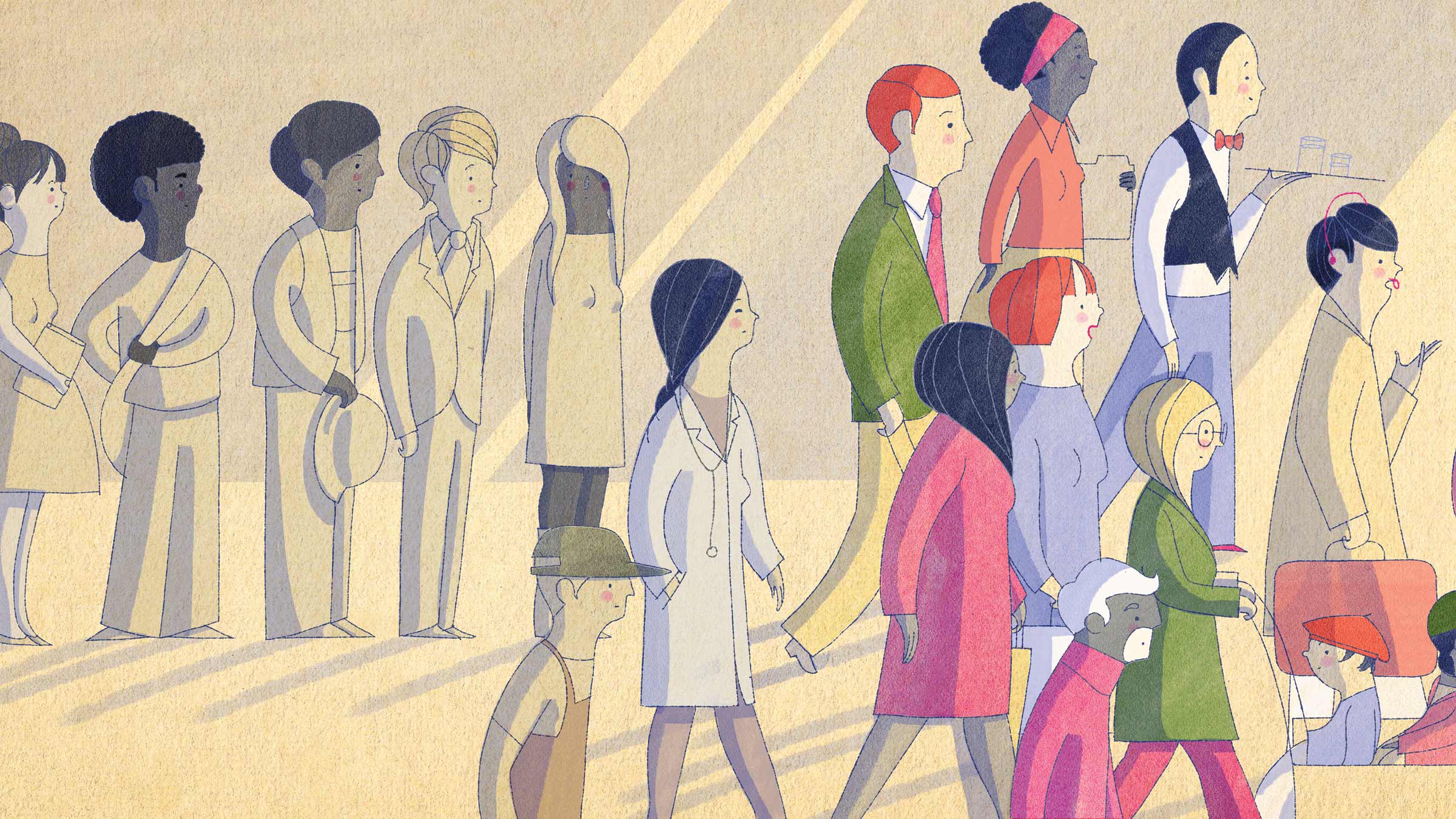With the right data, economists have the tools to quantify the effects of economic changes in the short run.
Say a state increased its minimum wage by $1. Give Erik Hurst data on wages, hours, and employment, and he can analyze what happened to wages and employment in the following year or two.
But more and more, Hurst, a professor at the University of Chicago Booth School of Business and a member of the Institute’s advisory board, is less interested in the short run than the long run.
“I have a series of papers in my mind that are started but not even close to being finished to try to address the question, How long is the long run? How long does it take for a full adjustment to some of these labor market changes?” Hurst said. “Is it centuries? Is it decades? Is it years?”
In the long run, firms will switch from workers to a less expensive input if wages rise too high. In the long run, labor will adjust to the decline of one industry and the rise of another. In the long run, workers will learn the skills to take advantage of the latest technologies. But the timing matters.
“If the adjustment process is sufficiently slow, it might cause us to prefer one policy to another type of policy for various reasons,” Hurst said. “I think that’s a question we don’t really think enough about. That’s where my heart is.”
This interview has been edited for length and clarity.
Economic growth, wage stagnation
In an article from 2023, you observed that for most of the 20th century, economic growth was associated with rising median wages, even after adjusting for inflation. However, since the early 1980s, the economy has been growing while real wages have not. What are the main reasons for this change?
Let me start with two other facts that I think are broadly related. First, we know that inequality has increased during the same time period, where wages at the top of the distribution have been growing sharply, even though median wages have been relatively stagnant. Second, we’ve also seen employment rates at the bottom part of the distribution declining more than at the median or at the top.
I’ve been thinking quite a bit about the joint set of these three facts. We have different names we call it—you can call it automation or skill-biased technological change or robots. They’re all relatively similar in their economic mechanism, where something has changed, in my view, on the production side as opposed to the demand side. The technological advances have been substitutes with some types of workers and maybe complements with others. We can see evidence of how this has displaced workers in the manufacturing sector because that’s easy to measure—manufacturing employment is spatially concentrated, and as a result, the job losses have put some downward pressure on wages and employment rates at the same time, just like a traditional labor demand shock would imply.
How we think about that automation and its effect on labor markets and its interactions with broader trends for certain types of workers, particularly the non-top part of the distribution, is an important research agenda for us to consider.
Do you think it’s likely that we’ll continue to see economic growth without wage growth? Or do you see recent economic developments as possibly changing that trajectory?
Every time we start to forecast out into the future, different patterns emerge. In the mid-2010s, we started to see the wages at the bottom part of the distribution actually narrow some relative to the median. And that has continued through the post-pandemic period as well. I have some work on how inflation could do some of that because workers at the bottom can switch employers more easily than workers at the top, and changing jobs tends to lead to wage growth. But this pattern predated the pandemic.
Now, this comes after a long period of time when there was no wage growth at the bottom. So how much of that is catching up? How much of it is selection of different people at different parts of the distribution moving into employment? I am not sure about any of this. So do I believe automation is still going to be there? Do I believe these forces could still have effects? Yes. That makes me pessimistic. But I am seeing signs that something is going on that’s moving things at the bottom part of the distribution as well.
Do you have a hypothesis for what has been driving real wages up at the bottom of the distribution in recent years?
When labor demand increases and needs some reallocation of people across sectors, you tend to get more of that at the bottom part of the distribution in the short run than the top part of the distribution, because workers at the bottom are more elastic.
For example, during the pandemic, when demand for waiters goes down but demand for delivery drivers goes up, that’s a pretty easy movement to potentially make. When finance goes down but robot making goes up, that’s an adjustment that will occur at the top end, but that takes time because it involves human capital development and a whole bunch of other things. And so the speed at which adjustment occurs to different types of shocks differs across the income distribution, both in the short run and the long run, depending upon the adjustments that are needed.
Why do economists care that wages are stagnating for a large chunk of the middle class while economic growth is still occurring?
For me, it is for the distributional consequences. In general, if productivity goes up, that’s better for somebody. We’re strictly better off with productivity going up. Now, how much of that is going to the workers at different parts of the distribution? How much of that is going to owners of the firms versus labor broadly? The money’s going to go somewhere. Productivity growth is good for economies.
So this is a distributional comment—how the gains from productivity growth get distributed. We do tend to know that when the middle class stagnates, it has spillovers throughout the whole distribution, through a variety of different socioeconomic or geopolitical forces. So I think, even if I’m just interested in long-run growth and I don’t care about the distribution, what happens to the distribution can be important for its effects on long-term growth through political populism, through incentives for human capital development, through socioeconomic events like drug use and suicide and crime. All of those tend to be related to these types of stagnation over a long enough period of time.
How do the incentives to invest in education and skill acquisition—human capital development—change due to wage stagnation?
The basic idea is that if I invest in getting certain types of skills, I might get some return in higher wages. There’s some cost to getting the skills and there’s some benefit. And if the cost is large in order for me to get the skills I need, then I might not do it at all.
I like to teach the labor market as a ladder metaphor. Quite often, if the rungs get very far apart, I might not be able to grab that upper rung to climb that ladder. And so having the rungs a little closer allows people to accumulate up by getting skills, moving to different occupations, taking some actions that could move you up the broad human capital distribution.
Inflation and market power
In a recent paper, you write that firms are better off from the recent burst of inflation because their market power increased. How does inflation increase firms’ market power in the labor market?
What it means is that our wages are relatively rigid. I don’t know about you, but I did not get a 9 percent increase in my earnings during the period when there was a 9 percent increase in inflation during 2022 and 2023. Maybe I got a 3 percent raise. But I don’t think I got 6 percent less productive during this period. What that means is resources have shifted from the workers towards the firms. My productivity didn’t fall, but my real wages fell.
Our wages are stuck. If you look at the distribution of wage changes in the U.S., which I’ve done using wage data from ADP, the payroll processing company, you see huge spikes at zero and huge spikes at 3 percent, a missing mass at 1 percent, and then a long tail beyond 3 percent. So it seems like zero and 2–3 percent are the raises most people get most of the time.
Why is that a norm? I don’t know. But given that norm, a burst of inflation traps people at their firm with wage increases that are between zero and 3 percent nominal, meaning real wages are falling. That’s exactly what we saw during the post-pandemic period, 2021 to 2024. Real wages collapsed in the distribution. So during this period of time, market power shifts towards the firm because nominal wages are sticky.
We see this in the data: We see that firm profits were at historically high levels in 2022, despite oil prices going up and despite supply chain backlogs. Profits were at all-time high rates in terms of the profit-to-GDP ratio, in part because they got one input, labor, at a substantial discount during this time period. And you can see in other periods of inflation, 1974 and 1979, profit rates also spiked in a relative sense.
Does the shift of market power from workers to firms depend on the underlying cause of inflation?
The shift is the direct effect of inflation. And then there’s the question, Where does the inflation come from? Which is a deeper question.
Thinking about the post-pandemic period, we had two shocks that moved in opposite directions in terms of labor demand. There was the pent-up spending that came from the pandemic coupled with a large influx of government spending. This caused us to spend more as consumers, and firms to want to produce more to meet our demand, so labor demand went up. On the negative side, there were supply chain backlogs and an increase in energy prices from the war in Ukraine, and that reduced labor demand. The net effect might be labor demand was relatively unchanged. How do we know? Because we saw inflation go up but GDP and employment did not move much relative to the pre-pandemic levels. This tells me that the two shocks probably had offsetting effects on demand for labor.
Now if we think about something like new tariffs raising inflation, that is going to be purely a negative supply shock. In that world, you’re going to have inflation, but you’re also going to have real declines in labor demand as well. And nobody’s going to be made better off by a negative labor demand shock.
A big rise in tariffs is like a negative productivity shock. Just as positive productivity shocks are going to be good for somebody, negative ones are going to be bad for somebody as well as the economy as a whole. The pie gets smaller in this case.
Robot shocks and labor force participation
One long-term trend that you’ve looked at is the decline in labor force participation among men. What are the causes of this decline, and what are the consequences?
I believe that automation and skill-biased technological change has been a big driver of the declining participation rates for men over this period. You can see it when you look at regional variation: Employment declines were biggest in the places where manufacturing was most concentrated. Not that manufacturing is the only sector where automation took place, it is just the easiest to measure because it is so spatially concentrated. So we can compare Region A to Region B using Region B as a control group to allow us to identify the causal effect of automation on employment.
So I believe that technology has been a large part of this decline. And then we want to know, If technology changes, how do people adjust? How long is the long run? If they adjust slowly, how does that interact with government programs we might want to use to mitigate some of the transition dynamics?
It strikes me that this situation of automation affecting certain sectors that employ certain types of workers is potentially very specific to this moment of time, and it’s unlikely to have occurred in the same way in the past or occur again in the same way in the future.
When I’m talking about this, I try to break it into three or four parts that help me think about technology’s effect broadly on the labor market.
So question one, Is the technology a complement or a substitute with workers in production? If it’s a complement, that’s great. If it’s a substitute, then the second thing we might want to know is, What is happening to the outside options to which these workers might move? Is the demand in other sectors for which these workers have similar skills growing at the same time this one sector is shrinking, or not? That makes a difference.
We’ve gone through robot shocks before. We called the “robot” a tractor, but the agricultural sector got automated away in terms of its employment rates. But it just so happened at a time when the manufacturing sector was growing, and the skill step size in that ladder metaphor between an agricultural worker’s skill on their rung of the ladder and a manufacturing worker on a similar rung of the ladder was small. My dad’s dad was an agricultural worker, my dad was a manufacturer. Sometimes you had to change locations because the agricultural jobs weren’t in the same place as the manufacturing jobs. So there was some adjustment. But the skill step size was relatively small.
Now, manufacturing is shrinking and professional services are growing, and that step size is a little bigger. So it’s not just whether the technology shock was a complement or a substitute with the worker. Both agriculture and manufacturing had shocks that displaced workers. The aggregate effects in the economy though depend upon what’s happening to other sectors at the same time.
The third question is, Does the technology shock play out quickly or slowly? If it happens slowly, we’re more able to adjust through natural attrition dynamics. People retire. Young workers move to new sectors. In the manufacturing scenario in the early 2000s, it was a quick shock. There was a lot of displacement as opposed to a slow atrophy, which is what we had before in agriculture. And so that made it a little bit more salient.
And then the fourth question, Are there policies to help with that transition? That depends on what the friction to adjustment is. Is it really a skill friction? And if so, how do we invest in skills? We know that’s hard. Are we doing job training programs? Are we thinking about vocational schools in community colleges? Are we thinking about whether everybody in high school needs to understand trig for the modern labor market? Maybe we could start adjusting the curriculum in high school or in community colleges or start apprenticeships in industry. Manufacturers today say, Ah, I can’t find workers. What they mean is, I don’t find the skilled workers I need to run the precision welding and the new fancy crane and things like that.
Apprenticeships are hard to sustain in equilibrium unless everybody does it. If your firm starts training some workers with apprenticeships, my firm is going to steal them as soon as you do. That’s why I’ve been thinking about tax credits for apprenticeships, to try to create an equilibrium where the training occurs at firms.
What are the questions and the economic patterns and behaviors that are capturing your attention now?
I really want to start thinking about adjustment process to structural changes like AI and automation more broadly. How does that adjustment process take place and how does that interact with policy?
I have another research area that uses models of worker sorting with frictions like discrimination to understand the effect on labor market outcomes and economic growth. My work with Chang-Tai Hsieh, Chad Jones, and Pete Klenow showed that reductions in labor market barriers, to women particularly but also to other groups, were important in yielding economic growth over time because it allowed people to move towards their comparative advantage in the labor market much more.
Pete, Chang, and I are doing some more work now about how the distribution of firm size growth is shaped and how changes in that distribution affect worker well-being in the labor market. I want to understand how the process of firm growth and worker wages interact. We know that firm entry has been declining over time. People refer to this as part of the declining dynamism of the economy. Can the decline in firm dynamism affect workers’ wages? We have fewer new firms and fewer small firms that grow fast. But, we will have more large, established firms. That brings us back to the same questions as before: Is declining firm entry going to lead to more wage inequality or will it mitigate inequality over time? I keep coming back to these inequality questions. I don’t know the answers to them yet, but I think it’ll be interesting.
This article is featured in the Fall 2025 issue of For All, the magazine of the Opportunity & Inclusive Growth Institute
Lisa Camner McKay is a senior writer with the Opportunity & Inclusive Growth Institute at the Minneapolis Fed. In this role, she creates content for diverse audiences in support of the Institute’s policy and research work.







